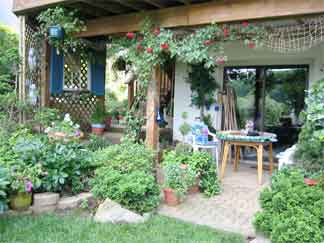With Ten Plants you can create 100 looks… and no two will be alike!
In landscaping a garden, patio, deck, backyard or front yard you can go a long way without knowing the name of a single plant – if you meet a smart nurseryman.
Let’s say you visualize a 6 to 8-foot high screen across one portion of your yard, a 1-foot high ground cover in another area, and a mass of light green or dark green along the foundation of the house.

Given just such broad specifications, a nurseryman can show you one or more plants that will do each job. The nurseryman in Maine, of course, would work with a different group of plants than the nurseryman in California; but as far as form is concerned they would be interchangeable.
We have worked out a system by which the “home or DIY landscaper” and a nurseryman can design a landscape and choose the plants for it.
It goes like this:
Listed from 1 to 10 below are groups of plants divided by their function in the landscape. In each group we have suggested several plants that will perform the function described. Remember the plants listed are not necessarily the ones recommended for your design. The actual plants that do what the listed plants do and fit you and your climate will be the final recommendation of your nurseryman.
1 -Carpets Thick and Thin
Typical large-area ground covers are.· the ivies, Japanese spurge; and shore, creeping, and Sargent junipers – all low growing, spreading types.
2 – Swatches of Color
Daylilies, iris, chrysanthemums perform this function. Low growing miniature roses, daisies and many perennials are also useful.
3 – Patterns
These are the plants that can be trained to create a pattern. on a fence or a wall: espalier dwarf apple, magnolia, pyracantha, and ficus repens.
4 – Accessories
Temporary color of the annuals and bulbs cannot hold the design of a landscape, but they give it change and excitement. Use them in quantity or sparingly.
5 – Framing – Low
This group contains the 1 1/2 to 3-foot permanent shrubs. Some formal, others informal. Such as: junipers, box leaf, Japanese holly, low azaleas.
6 – Framing – Medium
For building permanent frame 3 to 5 feet high. Try these shrubs: azaleas, mountain andromerda, yew, Japanese barberry, juniper, Chinese holly.
7 – Framing – High
These are shrubs that can be used as trees that can be pruned low. Examples: hollies, yews, pyracantha, rhododendrons, viburnum, Nootka cypress
8 – Screens and Walls
Small trees or trees that can hold to wall height. Choose from among flowering fruits, arborvitae, pittosporum, bottle brush, privet and the pines
9 – Accents
Plants of individual character like the Japanese maple, Hollywood juniper, pines, flowering crabapple, carmellias, podocarpus, Phormium tenax.
10 – Draperies – Coverings
Here the wisteria, winter Creeper, grape, rose, clematis, jasmine, honeysuckle, star jasmine. All are best when restrained by careful pruning.
